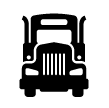Addressing Aggressive Driving

Aggressive driving puts you and others at risk of serious injury or death. According to the National Highway Traffic Safety Administration (NHTSA), aggressive driving occurs when an individual commits a combination of moving traffic offenses that endangers other persons or property. Speeding, tailgating, erratic lane changes, and failing to obey traffic signs are just a few unsafe driving behaviors that can escalate to road rage or cause a crash. Read the information below, and ask yourself how you can improve your driving style.
Recognize the Hazards
 Environment
Environment
Road construction, traffic congestion, and rude motorists can be stressful and bring out the worst in drivers. Likewise, work-related conflict or troubles at home can manifest themselves when a driver gets behind the wheel, resulting in aggressive driving behaviors.
 Equipment
Equipment
Misguided directions from a GPS unit, running low on fuel, or issues with the electronic logging device can lead to impatience, frustration, and possibly, aggressive driving.
 Personal Behaviors
Personal Behaviors
Aggressive driving may be the result of a variety of factors, such as an individual’s lack of professionalism, history of poor driving habits, or inability to cope with stress. Each factor can affect a person’s approach to driving.
Know the Defense
 Accountability
Accountability
Ultimately, the only thing a driver can control is him or herself. From the decisions made behind the wheel to the way the driver responds to adversity, controlling oneself is the greatest loss prevention technique. To help manage stress, try to resolve issues before driving or pull over and refocus.
 Maintain One Lane
Maintain One Lane
Avoid making erratic or unnecessary lane changes. Stay in one lane as much as possible to better manage the space around the truck. If lane changes are needed, signal well in advance.
 Observe Proper Speed for Conditions
Observe Proper Speed for Conditions
Do not try to keep up with the vehicles around you. Instead, reduce speed by 2-3 mph below the flow of traffic, not to exceed the posted speed limit.
 Maintain Proper Following Distance
Maintain Proper Following Distance
Do not tailgate. Keep a minimum of six seconds behind the vehicle in front of you. Add more space if additional hazards are present, like traffic congestion, road construction, and adverse weather.
 Yield the Right of Way
Yield the Right of Way
Never force your way into another driver’s lane. Plan ahead and use your turn signal. At intersections, yield the right of way, and do not block intersections while waiting for oncoming traffic to clear.
Note: These lists are not intended to be all-inclusive.
The information in this article is provided as a courtesy of Great West Casualty Company and is part of the Value-Driven® Company program. Value-Driven Company was created to help educate and inform insureds so they can make better decisions, build a culture that values safety, and manage risk more effectively. To see what additional resources Great West Casualty Company can provide for its insureds, please contact your safety representative, or click below to find an agent.
© Great West Casualty Company 2019. The material in this publication is the property of Great West Casualty Company unless otherwise noted and may not be reproduced without its written consent by any person other than a current insured of Great West Casualty Company for business purposes. Insured should attribute use as follows: “© Great West Casualty Company 2019. Used with permission by Great West Casualty Company.”
This material is intended to be a broad overview of the subject matter and is provided for informational purposes only. Great West Casualty Company does not provide legal advice to its insureds, nor does it advise insureds on employment-related issues. Therefore, the subject matter is not intended to serve as legal or employment advice for any issue(s) that may arise in the operations of its insureds. Legal advice should always be sought from the insured’s legal counsel. Great West Casualty Company shall have neither liability nor responsibility to any person or entity with respect to any loss, action, or inaction alleged to be caused directly or indirectly as a result of the information contained herein.




